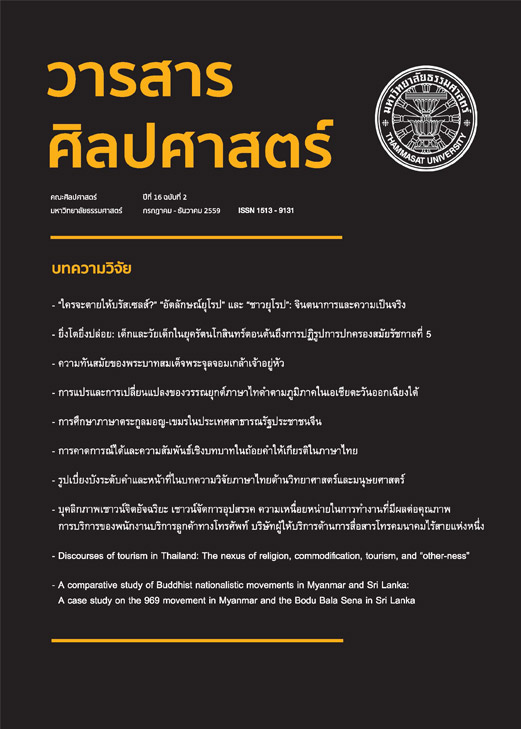การคาดการณ์ได้และความสัมพันธ์เชิงบทบาท ในถ้อยคำให้เกียรติในภาษาไทย
Main Article Content
บทคัดย่อ
การให้เกียรติเป็นปรากฏการณ์ที่สำคัญประการหนึ่งในสังคมไทยที่มีไว้ให้ผู้ที่ต่างกันด้านสถานะหรือผู้ที่สื่อสารกันอย่างเป็นทางการสามารถประกอบกิจกรรมในชีวิตประจำวันร่วมกันได้ด้วยความกลมกลืน การใช้ถ้อยคำให้เกียรติให้ถูกต้องตามบรรทัดฐานของสังคมเป็นหลักการที่สมาชิกในชุมชนภาษาควรปฏิบัติตามอย่างเคร่งครัดก็จริง แต่ก็มีหลายโอกาสที่ผู้สื่อสารไม่ได้ใช้ถ้อยคำให้เกียรติให้เป็นไปตามนั้น ด้วยเหตุนี้ การคาดการณ์ว่า ถ้อยคำให้เกียรติที่อาจปรากฏในโอกาสดังกล่าวจะปรากฏหรือไม่ และจะปรากฏในตำแหน่งใดในสถานการณ์การสื่อสารจริงจึงเป็นสิ่งที่ทำได้ยาก บทความนี้มีจุดมุ่งหมายที่จะศึกษาการปรากฏของถ้อยคำให้เกียรติในภาษาไทยจากข้อมูลการปฏิสัมพันธ์ที่มีความเป็นทางการจำนวน 2 แหล่ง ผลการศึกษาในบางแง่มุมสะท้อน ให้เห็นถึงการใช้ถ้อยคำให้เกียรติที่ไม่เป็นไปตามแบบแผน ผู้เขียนตั้งสมมติฐานเพื่ออธิบายวิถีปฏิบัติดังกล่าวว่า ถึงแม้ผู้พูดจะไม่ใช้ถ้อยคำตามแบบแผนของการให้เกียรติที่สังคมคาดหวังก็ตาม แต่พวกเขาก็ยังคงใช้ถ้อยคำให้เกียรติ รวมทั้งลีลาภาษาที่ไม่เป็นทางการอื่นๆ โดยคำนึงถึงความเหมาะสมของลักษณะความสัมพันธ์ที่หลากหลายระหว่างตนและผู้ฟังเป็นสำคัญ ผลการศึกษานี้นอกจากจะช่วยทำให้เรามองการใช้ถ้อยคำให้เกียรติของผู้ใช้ภาษาไทยในยุคปัจจุบันด้วยความเข้าใจแล้ว ยังปูทางให้เห็นการจัดการความสัมพันธ์ระหว่างบุคคลที่มีความลื่นไหลผ่านการใช้ถ้อยคำให้เกียรติและลีลาภาษาที่ไม่เป็นทางการผสมผสานกันไป
Exchange of honorifics is regarded as an important linguistic phenomenon in Thai society. It serves to promote interpersonal harmony among interactants with different statuses, or between those speakers interacting in formal settings. As a matter of principle, conventionalised use of honorifics is more often than not encouraged. However in real-life conversation, speakers may not always avail themselves of these forms. Therefore, projecting accurately whether particular honorifics will be called for, and which positions in a conversational turn they might be employed, is a very difficult task. This paper reports on a study that makes inquiries into the idiosyncrasies of honorifics in Thai, drawing upon two sets of data from formal interactions. Parts of the findings are testimony to the fact that conventions of honorifics are not adhered to for various reasons, and that occurrences of honorifics mixed with other less formal speech styles are commonplace in many of the examples investigated. A working hypothesis I put forward is that: despite breaching traditional norms of honorifics, speakers indulging in dropping honorifics, or replacing them with otherwise conventional speech, do so within an allowable unit, which consists of language devices they are deemed appropriate to the institutional, and other (possible) role relations, they assume and negotiate with the hearer at the moment of speaking. Approaching how and why honorifics, and their informal alternatives, can co-exist in this way not only allows us to consider this practice from an objective perspective, but also to make sense of the management of the often dynamic, and overlapping, social relations through style mixing most typical among many younger generation Thais.


